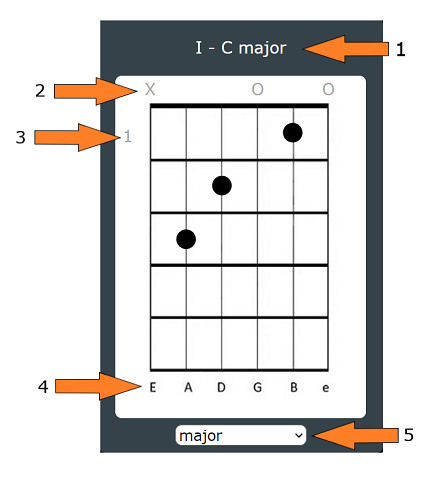How the chords are grouped
After selecting the desired key, a group of seven chords will be displayed. These are the chords that make up that key and are derived from the seven notes of the major scale. Each chord is assigned a roman numeral indicating its scale degree, with capital letters (eg I) indicating a major chord and lowercase letters (eg ii) indicating a minor chord. The chords can be played in many different sequences, however, some chord progressions are more common than others. Most songs you hear on the radio make use of the I, IV, V, and vi chords (but don't let that stop you from using others 😀). This app can be used by songwriters as a quick reference for finding different chords in the key they are working with.
How to read the charts

The chord charts are a graphical representation of the guitar fretboard and have black dots indicating where to place your fingers. Vertical lines represent the strings, with the low E on the far left and the high e on far right. Horizontal lines represent the frets. The diagram shows some of the other elements found on the cards.
- Chord number and chord name
- X & O indicators. An X means the string should not be played. An O means it should be played open (no fretting)
- Fret number indicating where the chart is on the guitar neck
- String letters
- Chord type. Use this dropdown to select among the different available chords.
Upcoming features
Currently the app has one version of each chord (usually the first position chord). In the future there will be more chord positions available as well as different voicings (inverted chords). Another addition will be the related secondary dominant and parallel minor chord families to give the user even more chord options to choose from. There is also a piano version of this app which will be released later on 🎹.
A note about the programming 💾
This web app interfaces to an API developed by Uberchord. The app sends the desired chord name to the API which then returns data used by the app to update the chord chart.
Contact 📧
For any comments, suggestions, or to say howdy, send an email to keyedupcharts@gmail.com
